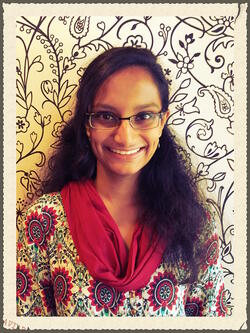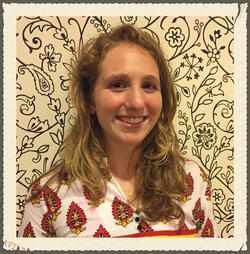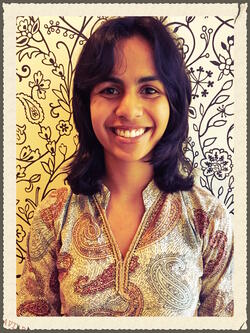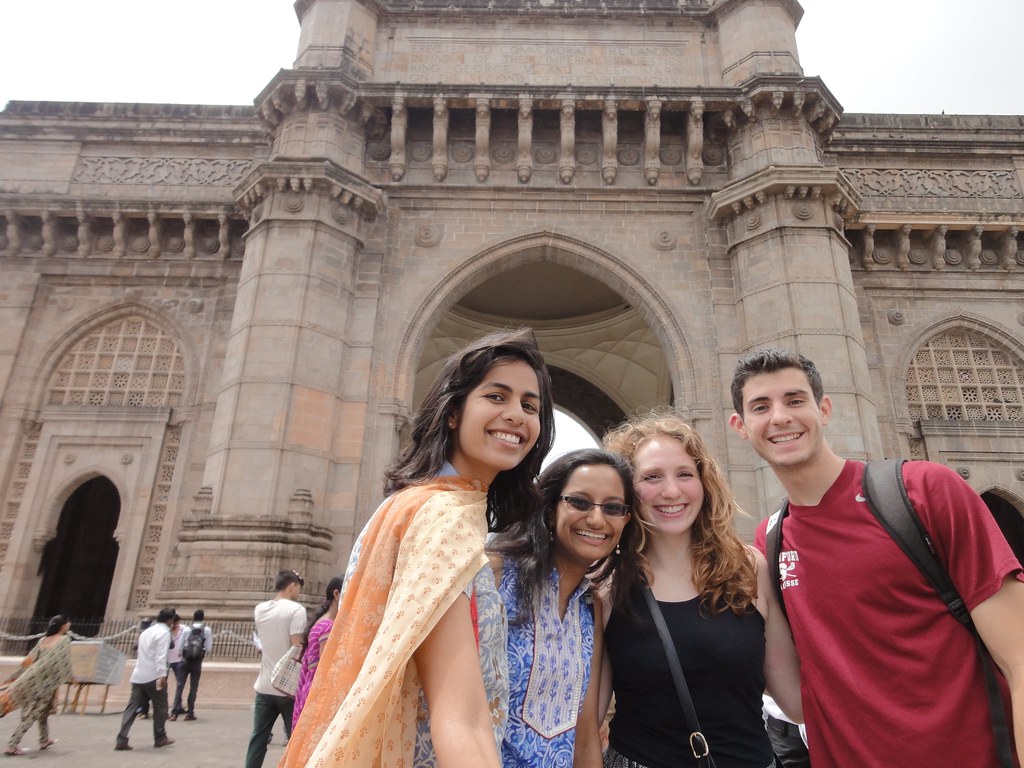Stanford students investigate India's pharmaceutical networks
Stanford students investigate India's pharmaceutical networks

MUMBAI, India – India’s colors, crowd and noises can overpower a newcomer. And the unfathomable wealth and crushing poverty that are both on display reinforce the sense that this is a country of extremes.
Four Stanford students embraced this savory sensory overload while navigating the labyrinthine Indian health-care system during seven weeks of research in the poor communities outside the financial capital, Mumbai, this summer.
“I think this experience has just hammered into me that it’s a very diverse country with a range of experiences,” said Lina Vadlamani, a Human Biology major just starting her senior year. “As one pharmaceutical owner said to us, ‘India might be poor — but the Indian people are not.’ There’s just so much going on here.”
One day they whizzed by bright Bollywood movie posters in belching auto-rickshaws and gaped up at Antilia, the 27-story mansion of a business tycoon considered the world’s most expensive home after Buckingham Palace.
The next, the students were talking to mothers of one Dalit community — members of the so-called “untouchable” Hindu caste — in the slums on the outskirts of Mumbai. They sat on the floor of a one-room community center taking notes as the women told them about their struggles to get access to medicine and doctors.
And yet another day, the students and their Indian colleagues and translators crouched in a small stucco pharmacy in the heat and humidity of the monsoon season while talking to a doctor about the procurement of traditional medicines.
The three Stanford seniors and one School of Medicine student were tracking access to health care, the quality of that care, and the way pharmaceutical networks impact medical practices in India. The Stanford India Health Policy Initiative fellows saw for themselves that the world’s largest democracy has become a microcosm of humanity’s bustling economic prosperity and yawning stretches of poverty.
“I think Mumbai is the place to see the extremes of inequality,” says Mark Walsh, an Economics major starting his senior year and a coterm who already has a Master’s in Public Policy with a focus on international development. “I’m just trying to think about how some of this great prosperity can be applied to the health problems that are affecting some of the most disadvantaged members of Indian society.”

Hadley Reid, another HumBio senior, and Pooja Makhijani, who just began her second year at the Stanford School of Medicine, are the other fellows. The students spent six days a week in the field for seven weeks and then would debrief one another every night back in their rooms on what they had learned that day.
“I’ve always thought I might be interested in doing international field work,” said Reid. “And I thought this fellowship would be a good way to experience that and see what’s really happening on the ground versus what you learn in the classroom.”
Navigating the three medical practices in India
Grant Miller, an associate professor of medicine and core faculty member at the Center for Health Policy/Center for Primary Care and Outcomes Research, directs the India Health Policy Initiative. The program, now in its third year, aims to work on the ground to identify obstacles to health-care delivery in the South Asian nation.
Miller gave the four fellows a mission: Spend your summer investigating the pharmaceutical networks that cater to the three main branches of Indian medicine:
The more mainstream Western practice of allopathy;
The traditional AYUSH system of medicine: ayurveda, yoga, unani, siddha and homeopathy.
And the large network of providers who have no formal medical training.
“The fellowship has two objectives,” said Miller, also a senior fellow at the Freeman Spogli Institute for International Studies. “One is to develop a nuanced, on-the-ground understanding of the practical realities that often cause otherwise promising health programs in India to fail. The other is to provide in-depth, non-clinical field experience to Stanford students interested in global health.”
Nomita Divi, program manager of the initiative, said the fellowship is designed to be demanding. During the preparatory spring quarter, the students brainstormed with a design-thinking expert about how to formulate their research and work toward specific goals. When the students return to Stanford later this month, they will focus on unpacking and analyzing the data and then writing a full report.
“Our aim is to expose students to the realities of field research in India and provide them sufficient time to grasp the realities on the ground, as well as provide them with the tools to assimilate their observations into a final report,” said Divi.
When they arrived in Mumbai in early July, the fellows went through a week of training with Veena Das, the renowned social anthropologist from Johns Hopkins University who is on the executive board of the New Delhi-based Institute of Socio-Economic Research on Development and Democracy (ISERDD). She taught the students how to conduct field research and compose discussion guides before they crossed the thresholds of more than 100 homes of patients and offices of physicians, pharmacists and drug wholesalers.
ISERDD is a nonprofit organization devoted to research on social and economic issues and is the leading partner of the Stanford initiative, providing decades of qualitative and quantitative data sets as well as field researchers who worked alongside the students all summer.
“Primary care in poor parts of India is centered around drugs,” Miller said. “This summer, our fellows focused on the relationship between pharmaceutical suppliers and health providers, many of whom work in the informal sector — that is, they lack formal clinical training of any kind.”
Only 1.3 percent of India’s GDP was devoted to public health in 2014, one of the lowest rates in the world, according to the World Bank. India still accounts for 21 percent of the world’s burden of disease, yet the amount of public funds India invests in health care is quite small compared to other emerging economies.
Most of the cost of health care falls to the patient in India, where 86 percent of the 1.2 billion people must pay for health care and medications on their own. While the private sector caters to Indians who can pay, the poor are left to rely on the often less-than-optimal public health care system and a network of family and friends.
Unproductive spending and corruption also cripple the system.

In the Field
Jaya Jadhav, a young mother in the Dalit community, explained to the students that they rely on a government nurse who comes once a month to hand out paracetamol. They have no local doctor to treat the more serious cases of typhoid and malaria, so must travel to the next settlement to see a doctor.
The women also turn to poorly trained practitioners who purchase wholesale drugs from small manufacturers and dispense these cheaper, unlabeled and often diluted pills to their patients.
As the students interviewed the women, a dozen children sat on the floor eating government-donated puffed rice and boiled gram from tiffin pots; mothers nursed beneath their saris and politely answered questions. At the end, the women asked shyly if the Stanford students had any medications they could share.
The students explained they were not doctors, but hoped that learning about the women’s daily lives would help them with their findings.
“Well, if it will one day benefit the women in the area, then this exchange of ideas about health is a good thing,” says Jadhav.
But the students weren’t always so sure.
“One of the things that I’m struggling with is the frustration of being able to do so little for these people, who basically have nothing but are ready to give us all their time,” says Makhijani, an American whose parents are from Mumbai. “But I realize I have the potential to be able to do that in the future, so I’m considering coming back to work here one day.”

Hoping for Results
Vadlamani — one of the HumBio majors who this fall also begins the Department of Medicine’s new coterm Master’s Program in Community Health and Prevention Research — applied for the fellowship because of its emphasis on field work.
““It makes us feel like detectives in a way,” said Vadlamani, who was born in the southern India city of Hyderabad and moved to the States with her parents when she was an infant. “I hope we would leave this experience with a couple of concrete areas that need to be focused on that would, down the road, lead to a policy change.”
Reid also believes their summer-long research will yield results.
“I’m not saying we’re painting the broadest, most accurate picture of the situation in India,” she said. “I know we’re taking a very small sample outside of Mumbai. But the hope is our findings will decrease some of the obstacles to effective policymaking for the health care system in India one day.”

Some of the key trends the students observed include the murky government regulations on certain classes of drugs, and the lack of knowledge about the current restrictions of antibiotic and steroid use among AYUSH doctors.
And compounding communicable diseases, such as tuberculosis and HIV/AIDS, Indians are increasingly suffering from non-communicable diseases as well.
“That’s happening across the developing world, these chronic lifestyle diseases such as diabetes and hypertension,” said Walsh. “And these families aren’t used to having to deal with these kinds of chronic diseases.”
The rural poor cannot afford to see a primary care physician who would school them in lifestyle changes to fight a potentially deadly disease such as diabetes.
And those who can afford a doctor in rural India often can’t find one.
India currently has some 840,000 doctors, or about seven physicians for every 10,000 people, according to the World Health Organization. That compares with about 25 in the United States and 16 in India’s economic rival, China.
The doctors the students did meet were generally overworked and struggling to keep up with all their patients and the shifting laws and regulations. But the students were forced to let go of some of their preconceived notions.

“Although there’s definitely a lot of gaps in knowledge, I’ve been surprised at how much doctors do know and how well trained they are,” said Makhijani, who often visits family in Mumbai, but had never ventured out into the poorer communities where her grandfather once ran a government hospital.
“I’ve never had such personal interactions with people living in the slums, with the doctors who are working here,” she said. “It really turns your perspective around, how resilient and creative they are.”
An Honor and Duty
Dr. Masood Ahmed Khan, a physician and pharmacist, spent nearly two hours with the students, with no prior knowledge that they would show up at his door and pepper him with questions about how he runs his unani practice.
When asked why he would give so much of his time, he said it was his “honor and duty” to help the students better understand the ups and downs of his medical community in one of the poor Muslim corners of Mumbai.
Dr. Khan then bid farewell with a cup of masala chai and this advice as they embark on their careers: “Go with empathy, go with humanity — and go with humility.”
View the photo gallery by clicking here or on the arrows below:
Beth Duff-Brown is the communications manager for the Center for Health Policy/Center for Primary Care and Outcomes Research. She joined the students in Mumbai for a week to blog about their research. You can read the blog postings here.

